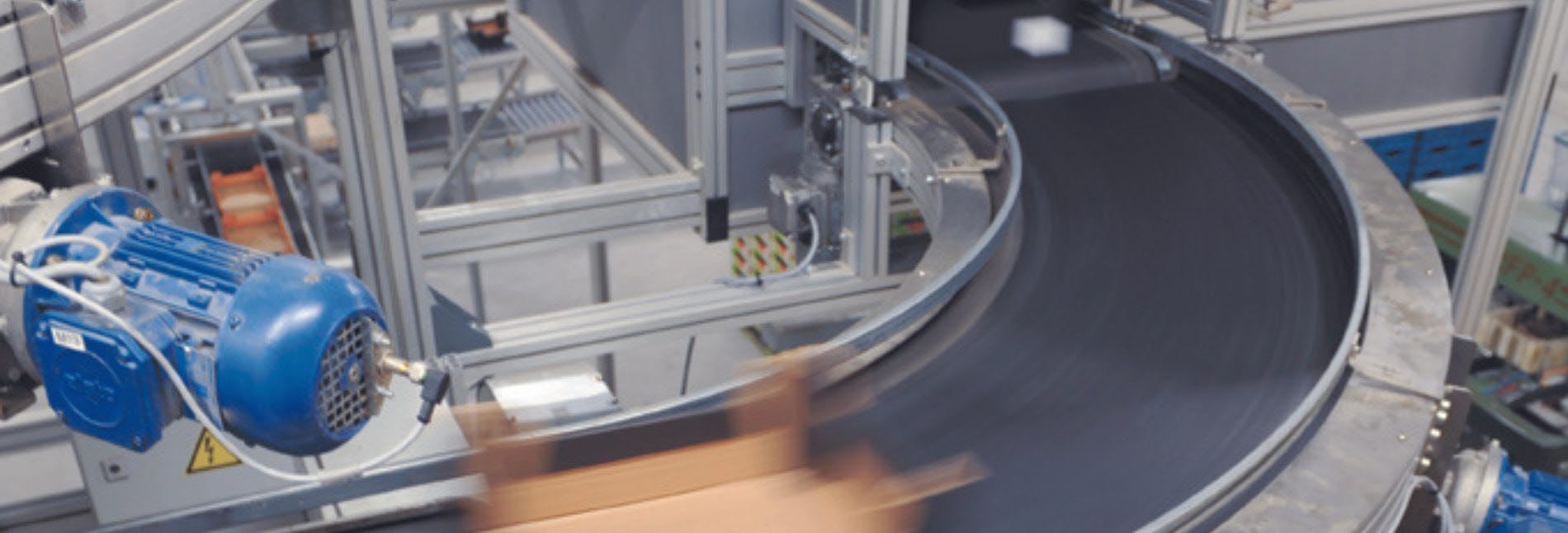Globale
Internazionale


05-04-2023
Curved conveyors are used in many industries like logistics, food, tyre, and building materials. They change the direction of product flow without changing its orientation. However, designing curved conveyors involves several critical aspects to make them function properly and efficiently. In this article, we’ll look at their design and explain how to choose suitable belts for them.
A curved conveyor is a conveyor in a curved shape that changes the direction of the transported goods without changing their orientation. This means the front side of the product remains facing the direction of travel when leaving the belt turn.
Curved conveyors transport piece goods, but they are not suitable for bulk goods.
Their other names include round conveyors or corner conveyors.
There are various types of curved conveyors, however, in this article, we’ll focus only on belted ones.
When designing a curved conveyor, there are a few aspects to consider providing an efficient and reliable operation.
The first would be a drive system. Curved conveyors can be friction driven, which makes them appropriate for high-load applications but causes extra wear. Other curved conveyors may use a positive drive system (such as a bow chain), or a toothed profile driven by a pulley. Such conveyors are less suitable for high-load applications but extend belt life. Positive-driven curved conveyors operate at a relatively low belt tension.
When tensioning a curved belt, the belt tension automatically pulls it inward to the inner radius of the conveyor. To counteract the inward forces, a belt guiding system is necessary. Some of the common solutions include:
A curved belt consists of one or more pieces of circular cut belt material spliced together to the shape of a cone. When turning this cone around pulleys, the angular velocity of the curve belt across the belt width is constant. This is not the case for the linear speed of the belt. The linear speed of the curve belt is linearly related to the radius of the curve.
The speed of a curved belt must be set so that the speed at the centre of the curved belt matches the belt speed of the connecting conveyors. As a result, the linear belt speed of the curved belt at all other places across the width of the curved belt does not match the belt speed of the connecting conveyors. This means there will always be some slip between the product and belt surface, both at the loading and off-loading points of the curved conveyor.
When designing a curved conveyor, it is also significant to plan transfer points accordingly to the products conveyed. Small products require small end pulleys because the transfer gap between the end pulleys and the connecting conveyors cannot be larger than half the length of the product. Curved conveyors with conical end pulleys have the disadvantage of having a larger pulley diameter at the outer radius of the belt. Consequently, the transfer gap where the product is not supported is also larger at the outer radius. Belt bends with cylindrical end pulleys do not have that disadvantage.
When selecting a belt for a curved conveyor, it's important to choose one that matches the application and the conveyor layout. Here are the key factors to consider when choosing a belt for a curved conveyor.
Whenever possible, it's best to choose a similar type of belt to that used for connecting conveyors. This will help you ensure that the belt is compatible with the application and has the right properties for the conveyor. The robustness of the curved belt and its top cover should match that of the connecting conveyors. To counteract the centrifugal forces pushing the product outward, choose a belt with a high-friction top cover. It will help to keep the product in place.
The belt for a curved conveyor should bend in the longitudinal, lateral, and any other direction. Therefore, it is preferable to use curved belts fabricated from non-laterally stable materials.
When a curved belt is running, the orientation of the warp and weft yarns flexing over the pulleys is constantly changing. This leads to unequal belt elongation, which causes guide rollers to generate noise. Increasing the number of splices will reduce the fluctuations in belt elongation and thus also the noise level.
When selecting a belt, always check the smallest pulley of the curved conveyor with the minimum advised pulley for flexing and back flexing. Consider the application, too. Belts must comply with industry standards like food contact approvals or flame retardancy.
Are you interested in curved conveyors? Would you like to design the right solution and choose appropriate belts? Contact our experts!